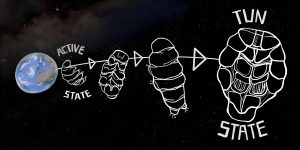EMMA HUIE | UTS WRITER | SALTMAN QUARTERLY 17-18
In 2016, the National Aeronautics and Space Administration reported a record-breaking 18,300 applications from aspiring astronauts (NASA). It may be surprising that so many people seem to be eager to launch themselves into space, considering that they would have to forgo Earth’s mild temperatures, clean water, and rich atmosphere of nitrogen, carbon dioxide, and oxygen (URSA). Space may be alluring, but it can be very unforgiving: along with the complete lack of oxygen, astronauts would be exposed to cosmic radiation, extremely low temperatures, and dangerously low pressures (Smithsonian).
While humans are unable to survive outside the comforts of Earth, the tardigrade, an aquatic micro-organism, is the first and the only animal known to survive conditions in space. Found in environments with temperatures ranging from -273 to 150 degrees Celsius, tardigrades can survive in extreme temperatures and can be found anywhere from the Himalayan mountains to the bottom of the ocean (Britannica). Studies have shown that the microorganisms can survive for months in severe environments, such as those that lack oxygen and water, have extreme salinity, radiation, and poisonous chemicals (Microbial Life).

In 2007, tardigrades faced the ultimate test of unlivable conditions. In an experiment conducted by the European Space Agency, 3000 tardigrades in capsule Foton-M3 were launched into space. Scientists found that after 12 days in space, many of the organisms had survived the overwhelming solar and galactic cosmic radiation. In fact, some had even laid eggs in orbit that grew into healthy adults (BBC).
All these amazing abilities come in a small package. Measuring about 1.5 mm, tardigrades have eight pudgy legs and rotund segments, making them look more like adorable caterpillars than hardy space pioneers. German pastor Johann August Ephraim Goeze first discovered them in 1773. Upon seeing their tiny claws, he decided to nickname them kleiner Wasserbär, which is German for “little water bear” (Greven). Later, the more technical name “tardigrade” came from the Italian clergyman Lazzaro Spallanzani, who called the slow-moving organisms “il Tardigrado,” meaning “slow stepper” (Microbial Life).
Despite unassuming outward appearances, tardigrades are highly resilient due to their interesting internal mechanisms. A tardigrade has the ability to withdraw into a “tun” state, in which it retracts its head and legs into its body, drying out to form an almost lifeless sphere (Britannica). To survive desiccation, tardigrades produce a special sugar called trehalose, which protects their proteins, membranes, and DNA. Additionally, trehalose can cover water molecules and prevent them from expanding at high temperatures, which would result in cells bursting (BBC). This ability allows tardigrades to stay in the tun state for years; to be revived, they only require a drop of water.
The tun state is extremely impressive, but it does leave tardigrades inactive and vulnerable to prey such as bacteria, fungi, and other tardigrades (Britannica). Although tardigrades use the tun state to survive decades in seemingly uninhabitable conditions, their natural lifespan is limited to about a year (NYTimes).
While humans may not be able to go into a tun state any time soon, there is still a lot to learn from tardigrades. Scientists can apply knowledge of tardigrade survival mechanisms in a variety of ways, from making crops that are resistant to climate change to developing technology that protects astronauts in space (TED-Ed). While the science is still developing, it will be exciting to see how tardigrades can contribute to humanity, as we push our own survival limits in the quest to expand into the final frontier.
[hr gap=”10″]
Resources
- http://www.bbc.com/earth/story/20150313-the-toughest-animals-on-earth
- https://www.nasa.gov/press-release/record-number-of-americans-apply-to-beanastronaut-at-nasa
- https://serc.carleton.edu/microbelife/topics/tardigrade/index.html
- http://www.esa.int/Our_Activities/Human_Spaceflight/Research/Tiny_animals_survive_exposure_to_space
- https://link.springer.com/article/10.1007/s11084-016-9522-1 (Weronika)
- http://www.popularmechanics.com/space/a11137/secrets-of-the-water-bear-the-only-animal-that-can-survive-in-space-17069978/
- http://www.lpi.usra.edu/education/explore/our_place/hab_ref_table.pdf (URSA)
- https://www.britannica.com/animal/tardigrade
- https://www.youtube.com/watch?v=IxndOd3kmSs&vl=en (TED-Ed)
- https://www.nytimes.com/2015/09/08/science/the-tardigrade-water-bear.html?mcubz=3 (Dean)
- https://manoa.hawaii.edu/exploringourfluidearth/biological/what-alive/properties-life/weird-science-cryptobiosis
- https://www.researchgate.net/publication/283615362_About_the_little_water_bear_A_commented_translation_of_GOEZE’S_note_Ueber_den_kleinen_Wasserbar_from_1773 (Harmut Greven)
Featured image by Vicky Hoznek.

